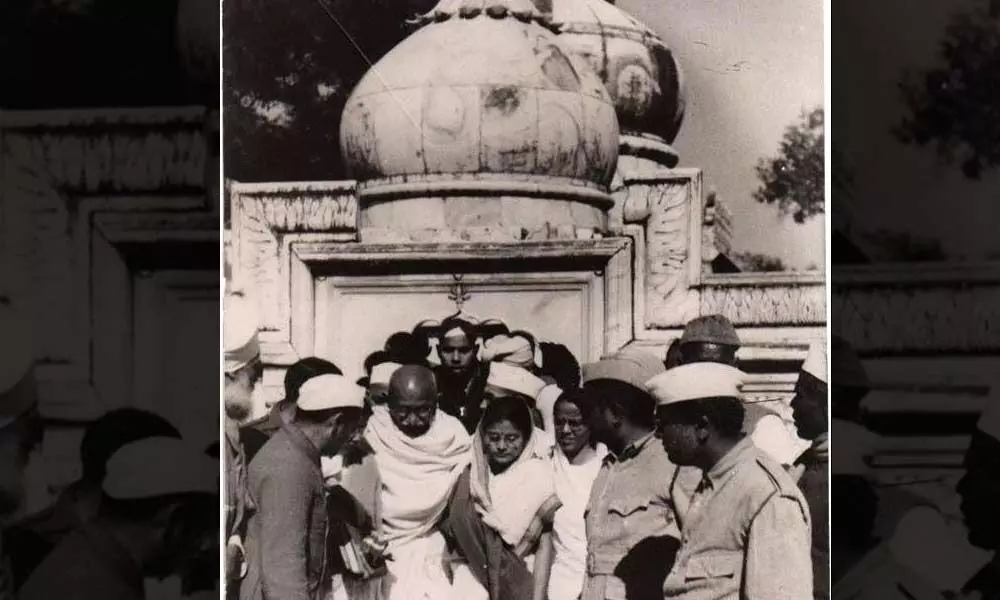Gandhi's last act: He visited dargah just 3 days before his death
The weak and weary 79-year-old Mahatma Gandhi visited the Qutbuddin Bakhtiyar Kaki Dargah in Mehrauli to see the damage done to it during the communal riots
image for illustrative purpose

Just nine days after ending his last fast on January 18, 1948, to bring sanity in Delhi, which was engulfed in an unprecedented communal violence and three days before he was assassinated, weak and weary 79-year-old Mahatma Gandhi was visiting the Qutbuddin Bakhtiyar Kaki Dargah in Mehrauli.
It was freezing cold in Delhi and he reached there before 8 in the morning to see the damage done to it during the communal orgy. He was very upset that in the name of religion Muslims were attacked in their own land. He was there with Maulana Azad and Raj Kumari Amrit Kaur. Even though it was Urs time there, yet the mood was sombre and Bapu was unwell as he was on fast till recently. After this holy place was attacked and vandalised, many local Muslims left their homes for safer places. Even staffers of Dargah abandoned it as they feared for their lives. They too moved to safer places.
Those were the days when only villages constituted entire Mehrauli area. IIT and various South Delhi colonies like Green Park, Hauz Khas and Safderjung Development Area (SDA) came up only after mid 1950s. "Bapu was devastated to see some part of the dargah damaged. It was being attacked by refugees coming from Pakistan. They were given make-shift accommodation close to the Qutbuddin Bakhtiyar Kaki Dargah by the government," writes Pyare Lal Nayar, Bapu's PA, in 'Mahatma Gandhi Purnahuti.'
At the dargah, he appealed to everybody to live peacefully. He asked refugees to rebuild the damaged area. Gandhiji had asked Prime Minister Pandit Jawaharlal Nehru to get dargah repaired as it had sustained extensive damage during the riots. Further, Gandhi ji asked Nehru to allocate
Rs 50,000 for the damages. Of course, it was a huge amount in those days. After his visit, Gandhi himself wrote, as per his collected works (Volume 98 p.98-99): "Esteemed as second only to the shrine at Ajmer, it (the Qutbuddin Bakhtiyar Kaki Dargah) is visited every year not only by Muslims, but by thousands of non-Muslims too."
Before leaving Dargah, Gandhi told the large assembly, "I have come on a pilgrimage. I request, Muslims, Hindus, and Sikhs who have come here with cleansed hearts, to take a vow that they will never allow strife to raise its head, but will live in amity, united as friends and brothers. We must purify ourselves and meet even our opponents with love."
Visited shrines only twice
In his total 744 days stay in Delhi from 12 April 1915 to fateful 30 January 1948, he visited religious places only twice in Delhi even though he was a devout Hindu. He inaugurated the Birla Mandir on September 22, 1939 on the condition that the entry of dalits would not be barred there. And second time when he visited any shrine, it was the dargah. Yes, he lived in a tiny room at Valmiki Mandir too in Delhi where he used to teach kids of Valmiki families. That black board is still intact which was used by none other Mahatma Gandhi during his classes to teach his students. Bapu stayed at Valmiki Mandir there in then Reading Road ( now Mandir Marg) for exactly 214 days from 1 April 1946 to 10 June, 1947. Here Louis Fischer used to interview him before writing his great biography 'The Life of Mahatma Gandhi.'
"This shrine was subjected to the wrath of mobs. The Muslims living in the vicinity… for the last 800 years had to leave… Though Muslims love the shrine, today no Muslim can be found anywhere near it… It is the duty of the Hindus, Sikhs, the officials and the Government to open the shrine again and wash off this stain on us… The time has come when both India and Pakistan must unequivocally declare to the majorities in each country that they will not tolerate desecration of religious places, be they small or big. They should also undertake to repair the places damaged during riots," Bapu also said.
Bakhtiyar Kaki Dargah comes alive every year during autumn time when Phool Walon Ki Sair, the annual Delhi festival that celebrates communal harmony takes place here. It is indeed a tribute to Gandhi ji who stood firm that India has to survive on secular ethos. The seven day festival was revived by the then Prime Minister Nehru in 1961. During the festival, both Hindus and Muslims offer floral chaadar and pankha at the Dargah and floral pankha and canopy is offered at the ancient temple of Devi Yogmaya, also in Mehrauli.
Alas, there is no plaque here at the Qutbuddin Bakhtiyar Kaki Dargah that can give an idea that this place has very strong connections with Gandhi ji. Sadly enough, those who work at dargah have no clue at all why Gandhi came here on 27 January 1948?
(The author is a Delhi-based journalist who closely follows South Asia, business, Delhi and Indian Diaspora)

